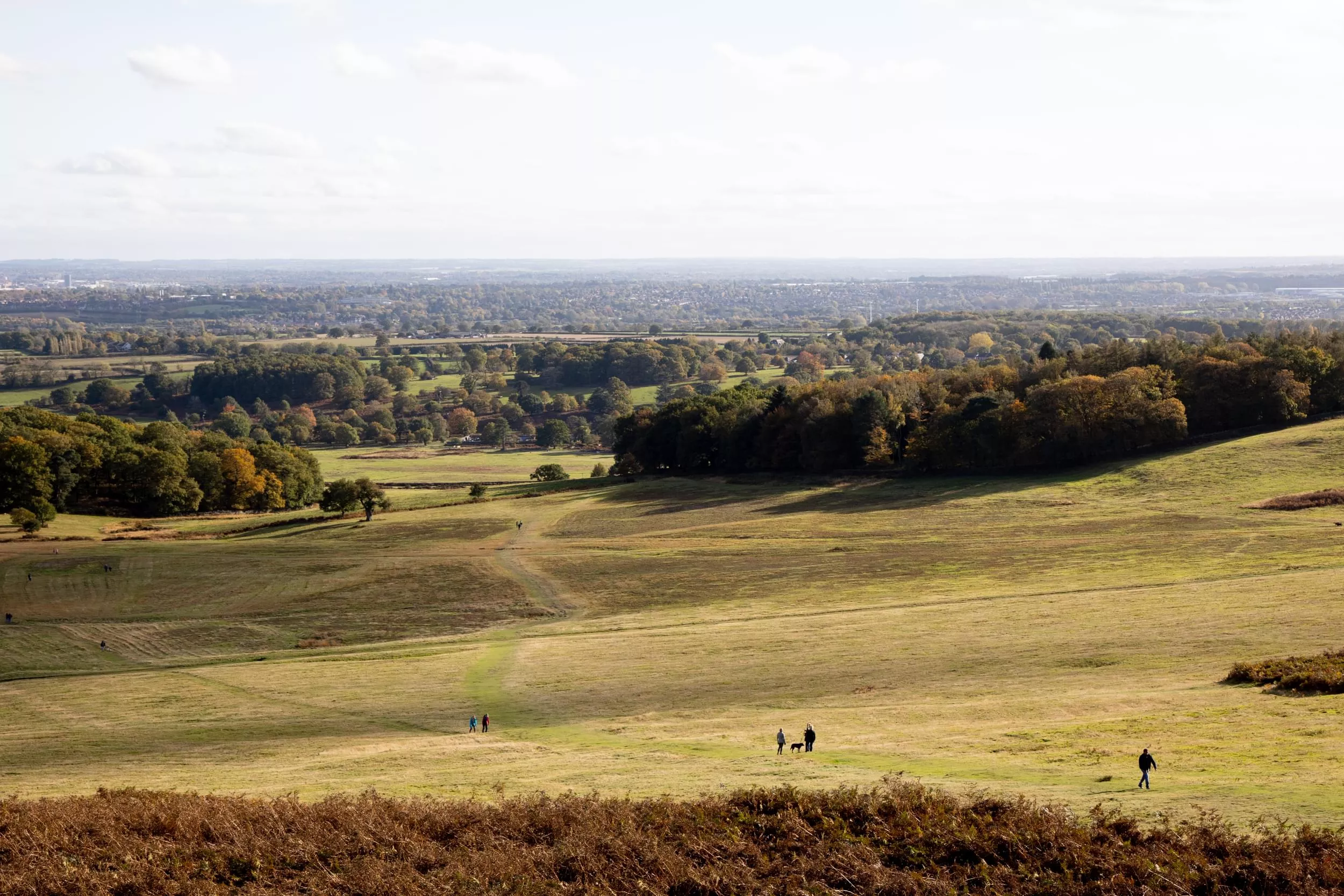There's always somewhere new to visit in the National Forest, with an array of unique attractions to explore and discover.
Browse the National Forest Map and explore this destination and things nearby.
Added to basket

Route details

Long
15 miles

Time
TBC

Map
OS Explorer 245 The National Forest

what3words
finds.stays.slot

Os Grid Ref
SK523098

Start
Newtown Linford Car Park, LE6 0HB

Path type
Unsurfaced paths, tracks, woodland trails and farmland.

Accessibility
Steep inclines and uneven ground Steep inclines and uneven ground.
Browse the National Forest Map and explore this destination and things nearby.
Summary
This 15-mile walk takes you to the four peaks that define Charnwood Forest.
Along the way you will pass, gnarled oak trees, some of the oldest rocks in Britain, visit historic deer parks and take in some spectacular views.
Charnwood Forest is famed for its craggy hills and dry stone walls, but is also rich in wildlife. Look out for buzzards circling on the updrafts from the hills.
PLEASE NOTE:
Sections 10 to 11: We have been made aware that the permissive route through these sections is currently impassable. We are working to address this - in the meantime it is advisable to use the roads, although these are busy with fast-moving traffic so walk with care.
Sections 12 to 14: Due to quarrying activities, the footpaths in this area are subject to temporary diversions. Please follow the footpath signs in this area to use the diverted routes. A downloadable map showing the diverted routes is available on the Leicestershire County Council website https://www.leicestershire.gov.uk/roads-and-travel/cycling-and-walking/where-to-walk-in-leicestershire
Walk highlights
It is difficult to imagine what the English countryside looked like back in the Middle Ages. But in Bradgate Park we have a glimpse of the ‘wasteland’ that comprised Charnwood Forest back in the days of the Norman Conquest. Too poor for cultivation, the land has been preserved as a deer park for at least 800 years. The mixture of heathland, grassy slopes, rocky outcrops and small woodland spinneys looks today much as it would have done a millennia ago.
Bradgate features strongly in England’s history – its most famous occupant was probably Lady Jane Grey who has the dubious distinction of being England’s most ephemeral Monarch.
The Park is noted for its stunted oaks. A local legend says that the oaks were pollarded as a sign of mourning when Lady Jane Grey was beheaded and have never recovered since. No doubt rooting into thin soil over volcanic rocks has its effect too!
Crowning the highest hill in Bradgate Park is Old John – a folly in the shape of a huge tankard. Built in 1784, it replaced a windmill that had stopped working and was originally used as an observation tower at the centre of a mile-long practice horse gallop. Set into the rocks to the south of the Tower are the surviving portions of stables built in the mid-19th century for the Seventh Earl of Stamford’s racehorses.
The folly is well known for its mug shape, the ‘handle’ of which was added later - reputedly in memory of a beer-loving family retainer who died in 1786 when a great pole, set up in the middle of a celebratory bonfire for the coming of age of George Harry (the future Sixth Earl of Stamford), toppled over.
In 1970, Mr. & Mrs. Charles Frears of Woodhouse Eaves purchased Broombriggs Farm at auction and gave it to Leicestershire County Council “for the quiet enjoyment of the people of the county and city of its natural beauty and fine views and to encourage their interest in farming”. It is a 55ha mixed arable and stock farm, and has a 1.5 mile farm trail with information boards explaining the working of the farm.
At 248m (814ft), Beacon Hill is the second highest point in Leicestershire and commands a wonderful view. A toposcope shows the landmarks that can be seen from the summit. The panorama is made up of the Soar and Trent valleys to the north and Charnwood Forest and Leicester to the south. On a clear day, you can see the spire of Lincoln cathedral.
Directly north is Ratcliffe Power Station, with what appears to be two cooling towers. Seen from any other direction it is clear that the power station has 8 towers but they have been specifically aligned to give a reduced profile in the view from Beacon Hill.
The hill probably takes its name (along with most of the other Beacon Hills in England) from its use as a site for a signalling beacon and it is thought to be part of the Elizabethan early warning system for the approach of the Spanish Armada. Look out for an unusual formation in the rocks below the summit to the northwest, which has been christened the ‘Old Man of Beacon Hill’.
Earthworks on the hill are the remains of a hill fort constructed in the Bronze Age (around 3,000 years ago). Bronze bracelets, an axe mould and spearheads have all been found on Beacon Hill in the vicinity of these prehistoric earthworks and are all on display at the Jewry Wall Museum, in Leicester.
The Vale of Charley is an unsung gem of a little valley. In the middle ages, the manor of Charley must have seemed an ideal place for a retreat – an isolated area of cultivated land, entirely surrounded by the natural woodland and rough open grazing land known as the Waste of Charnwood. Sure enough, sometime in the twelfth century, the vale gained a small Augustinian priory, located on the site of the present Charley Hall.
At 278m (912ft) the “Olympus of Leicestershire” is officially 1088 feet short of a mountain but is still a prominent peak and the highest point in The National Forest and Leicestershire. On a clear day you can see the Sugar Loaf in South Wales, the Malvern and Shropshire Hills, summits in North Wales and Derbyshire and Lincoln Cathedral.
The hill has two very distinct faces – one half preserved as a Site of Special Scientific Interest (SSSI), the other forming Bardon Hill Quarry.
This small area of rock and surrounding meadow is actually part of the rim of an ancient volcano and a regionally important geological site due to its rock outcrops of Markfieldite.
Long before William the Conqueror fought his way across England, “Billa” was a popular name in Old English. It has been suggested that Barra could be a corruption of barrow, meaning burial ground, which would link the location with the stories of a Saxon battle on the adjacent land and burial of the dead on the hill. However, the quarrying that occurred on the hill up until the 1950s would have destroyed any physical evidence. During the 1990s, Hinckley & Bosworth Borough Council purchased the site. About 10,000 trees, mostly local English oak and silver birch, have been planted on the flatter areas around the hill.
In the south-east corner of the site you will find a Noon Column. Created by internationally renowned artist David Nash, this sculpture is aligned so that the sun shines through a vertical slot at ‘true’ noon each day, creating a line of light in the shadow cast by the column. Made of English Oak and standing beside a section of dry-stone wall built by local volunteers, the scene captures the rugged upland character of the Charnwood Landscape.
Markfield Knoll Hill was once one of four granite hills in the area, the other three being Billa Barra, Cliffe Hill and Bardon Hill. Each has been extensively quarried for their stone. Hill Hole Quarry was opened in 1852 and many houses were built to accommodate the new employees – the stone built terraced houses behind the Parish Church known as ‘New Row’ being good examples. The quarry was a dangerous place to work and at least 6 employees died there in the latter half of the 19th century. These days the water filled quarry is still a hazard and no diving or swimming is allowed.
Facilities
Where to eat
There's always somewhere new to visit in the National Forest, with an array of unique attractions to explore and discover.

Help us to maintain our trails for others to enjoy, by reporting any issues you come across.
